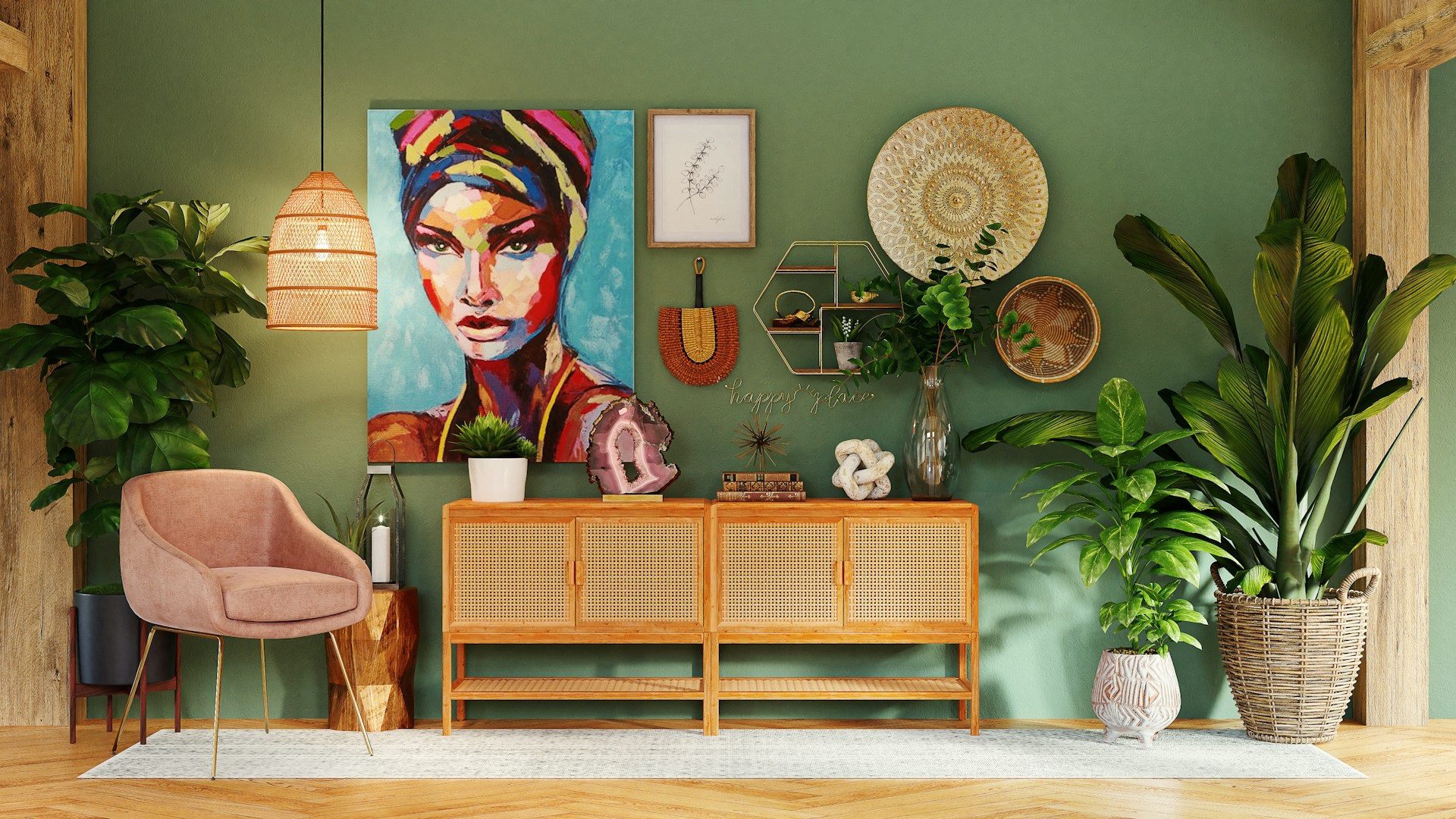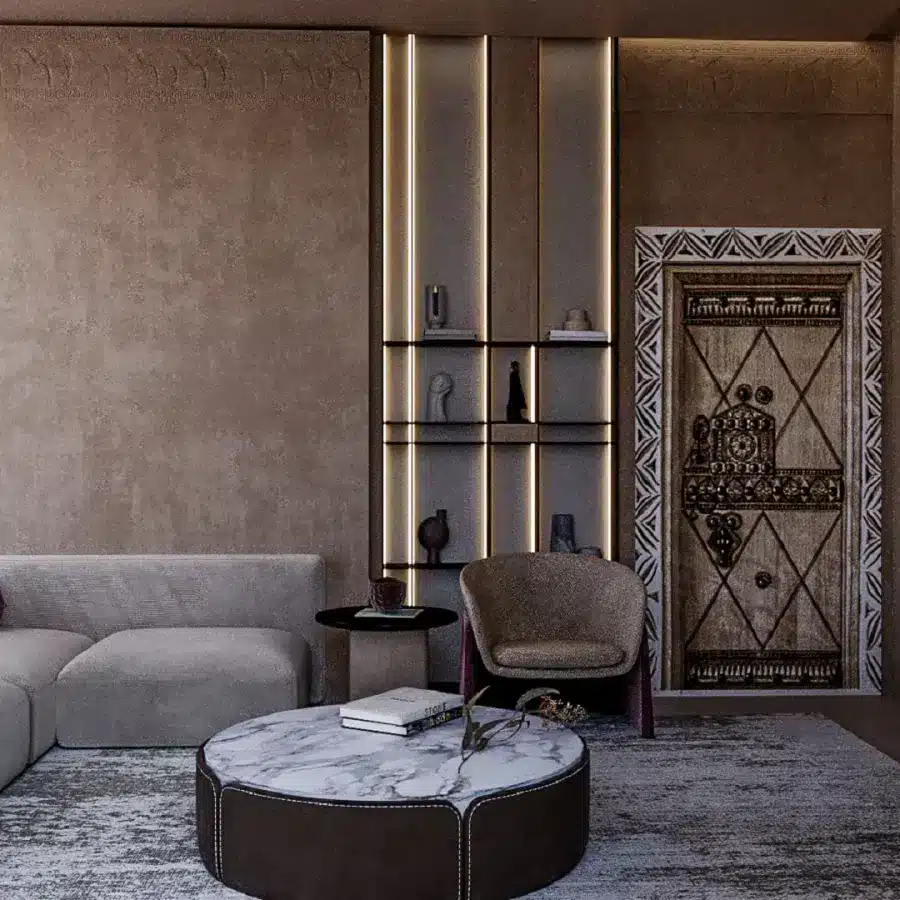
Blog
Najdi doors and how to use them in your home decor

In the context of reclaiming elements of heritage and drawing inspiration from it in contemporary home decor, it is noticeable that Najdi doors are finding their place in interior spaces, even if the latter follow modernity in style. The move expresses the home owners’ culture, their desire to combine the old and the new, the timeless trend in interior decoration, identity, folklore, and aesthetics.
In the following lines, Loujain Al-Fares, an architect and designer, talks about Najdi doors and how to properly utilize them in contemporary home decor.
جدول المحتويات
The place of doors in interior design

Modern majlis, noting a carved door in the Najdi style. The pattern is repeated on the wall behind the sofa
According to Loujain Al-Fares, an architect and designer, doors play an important role in interior design; beyond simply separating spaces, they greatly influence the flow of movement and energy, magnify the sense of space, and enhance the visual identity of architectural spaces.
The architect summarizes the place of doors in interior design, saying they are “an address for homes, whether they are installed at entrances, or they separate spaces.”
“Modern doors have become integrated into the decor of the walls of the rooms and are treated as part of the walls, whether the doors are visible or hidden, in addition to their importance in sound and thermal insulation,” she adds.
Doors with Najdi carvings

A huge door carved in the Najdi style
“Najd is known for its folk art, which is called Najdi art, which is represented in decorating doors, designing windows, and providing them with decorations and inscriptions, the latter of which are inspired by the surrounding environment and are characterized by simplicity, spontaneity, and distance from complexity, and are based on geometric and botanical forms, such as large triangles, intersecting lines, leaves, and palm fronds: Large triangles, intersecting lines, leaves, and palm fronds.”
“The engravings lean towards abstract art, which reduces details, and are a way of expressing the beauty, balance, and environment of a bygone time. Of course, there are meanings to some of the inscriptions, such as: Overlapping triangles, expressing stability and strength, while curved lines represent movement, life…”
“The latter was used as a means of expressing the status of a family or a person, as heavily decorated doors signaled wealth and high status in society,” she says.
In terms of aesthetics, the inscriptions were used to enhance the appearance of the entrance, making it look more luxurious and welcoming to visitors to the house.”
The presence of Najdi doors in the contemporary home

A carved Najdi style door for a modern living room
As Najdi doors are related to heritage and identity, their presence in the contemporary home indicates an attachment to identity, social values, respect for heritage, and symbolizes luxury and high social status.
According to the engineer, patterned doors are used as an aesthetic element, but they are also functional and serve an important function: Maintaining privacy and insulation
Overall, the balance between beauty and function reflects a thoughtful approach to home design, combining elegance with practicality.
In response to a question about the places where Najdi doors are placed, she says:“The entrance of the houseis a candidate for receiving this type of door, which gives a luxurious impression among visitors to the house and reflects the taste and culture of its people, without losing sight of the attractiveness of the doors mentioned.”
“Doors can also be used in formal rooms, majlis entrances, and reception rooms,” she adds, noting that “in some large traditional houses, Najdi doors are present at the entrances to private rooms or large halls, and this type of door adds a sense of ethnicity and sophistication to private spaces.”
Materials and colors used to make Najdian doormats
Najdi doors, which are used in interior design, are made of solid wood, such as: Sidr, teak, or oak, due to the durability of these types of natural materials and their resistance to the harsh climatic changes in the desert region, including high heat, dryness, and ease of molding and carving.
According to the engineer, large decorative nails or iron sheets are used to reinforce the doors, noting that the large iron nails are not only meant to add strength and durability to the doors, but are also part of their aesthetic design. Heavy iron rings and handles are used to add a touch of heritage and strength, as well as small colored pieces of glass.
The colors of the Najdi doors, like the old traditional ones, are colored in the colors of natural wood, from dark brown to light brown.
Sometimes the doors are covered with a layer of natural oils or wax to protect them and highlight the natural color of the wood. On the other hand, Najdi doors may be painted in traditional colors, such as: blue, dark red, or earthy colors that are associated with culture, warmth, and welcome.
Tips for Homeowners
If a homeowner wants to have Najd doors in her space, whether it’s in the main entrance or between guest rooms, there are a number of tips to keep in mind:
- It is important that Najdi door designs harmonize with the other elements present in the home, especially if the latter follows a modern or contemporary style. In this context, you can incorporate simple and modern details with Najdi doors, such as: Smooth edges, and the distribution of austere furniture in the places where the doors are located, to maintain the balance between the old and the new. In homes with a heritage or rustic theme, the style can be enhanced by using earthy colors and motifs for other surrounding elements that match the Najdi door designs.
- Lighting accentuates the beauty of Najdi doors; therefore, it is preferable to use appropriate lighting to highlight the details of the doors, such as carvings and decorations. In this context, side lighting, or lighting hidden in nearby ceilings, can be effective.

Loujain Al Fares, Architect and Designer
